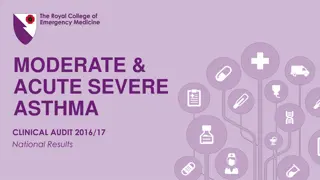2022 Financial Audit Manual Update Overview
This content provides details on the 2022 Financial Audit Manual update, focusing on significant changes to GAO/CIGIE FAM Volumes 1 and 2. It covers key amendments, revised examples of engagement letters, and communication requirements for auditors. The update also highlights changes in AU-C standards and categories of assertions in financial audits.
Download Presentation

Please find below an Image/Link to download the presentation.
The content on the website is provided AS IS for your information and personal use only. It may not be sold, licensed, or shared on other websites without obtaining consent from the author.If you encounter any issues during the download, it is possible that the publisher has removed the file from their server.
You are allowed to download the files provided on this website for personal or commercial use, subject to the condition that they are used lawfully. All files are the property of their respective owners.
The content on the website is provided AS IS for your information and personal use only. It may not be sold, licensed, or shared on other websites without obtaining consent from the author.
E N D
Presentation Transcript
2022 Financial Audit Manual Update Josh Marcus, Assistant Director Government Accountability Office May 26, 2022 2022 CIGIE/GAO Financial Statement Audit Conference
Objectives Participants will learn about significant changes to the GAO/CIGIE FAM Volumes 1 and 2 Significant changes are primarily based on changes in: AICPA Statements of Auditing Standards Nos. 134, 135, 137, 138, 140, 141 OMB Bulletin No. 21-04, Audit Requirements for Federal Financial Statements Other changes were also made to improve clarity and guidance Users should also consider any subsequently issued standards or guidance
Background How is the FAM Structured? Volume 1 FAM 100s-500s: Introduction, Planning Phase, Internal Control Phase, Testing Phase, Reporting Phase Volume 2 FAM 600s-1000s: Detailed Implementation Guidance Volume 3 Federal Financial Reporting Checklist
Background Current revisions to FAM Volumes 1 and 2: GAO and CIGIE worked jointly to make updates Currently out for limited exposure with the IG community Comments due May 31, 2022 Expect publication in early summer 2022 Upon publication, should be used immediately to audit federal entity financial statements
SAS 134 - Auditor Reporting and Amendments, Including Amendments Addressing Disclosures in the Audit of Financial Statements Terms of Engagement (AU-C 210) FAM 215 A example engagement letters revised to incorporate changes to illustrative examples provided by AU-C 210. Auditor s Communication with Those Charged with Governance (AU-C 260) FAM 215 incorporates changes from AU-C 260 regarding communicating with those charged with governance about significant risks identified by the auditor. FAM 550 revised to include requirements from AU-C 260 to communicate about significant unusual transactions, circumstances that affect the form and content of the auditor s report, and matters that are difficult or contentious for which the auditor consulted outside the engagement team and that are, in the auditor s professional judgment, significant and relevant to those charged with governance.
SAS 134 (Continued) AU-C 315, Understanding the Entity and Its Environment and Assessing the Risks of Material Misstatement Assertions about classes of transactions, account balances and related disclosures: o Previously, AU-C 315 provided 13 assertions within 3 categories. o AU-C 315 now provides 12 assertions within 2 categories, with the 3rd category (Presentation and Disclosure) being incorporated into the first two categories. The FAM provides 5 broad categories of assertions and a crosswalk between the FAM assertions and the AU-C 315 assertions. This crosswalk has been revised to reflect the revised AU-C assertions.
SAS 134 (Continued) Performing Audit Procedures in Response to Assessed Risks and Evaluating the Audit Evidence Obtained (AU-C 330) FAM 470 revised substantive audit procedures related to the financial statement closing process to include agreeing or reconciling information in disclosures. FAM 560 added guidance for evaluating whether the overall presentation of the financial statements is in accordance with the applicable financial reporting framework (e.g. U.S. GAAP) from AU-C 330 and AU-C 700. Evaluation of Misstatements Identified During the Audit (AU-C 450) FAM 540 clarified information about: o accumulating and evaluating misstatements in the financial statements and note disclosures. o identifying and evaluating misstatements in qualitative note disclosures.
SAS 134 (Continued) Forming an Opinion and Reporting on Financial Statements (AU-C 700) Updated example audit reports in FAM 595A and 595B o Updated organization, format, and section headings o Edits to Auditor s Responsibilities for the Audit of the Financial Statements Modifications to the Opinion in the Independent Auditor s Report (AU-C 705) Updated guidance in FAM 580 related to when the auditor issues a modified audit opinion
SAS 140 - Amendments to AU-C Sections 725, 730, 930, 935, and 940 to Incorporate Auditor Reporting Changes From SAS Nos. 134 and 137 Emphasis-of-Matter and Other-Matter Paragraphs in the Independent Auditor s Report (AU-C 706) & Required Supplementary Information (AU-C 730) RSI, other information, and going concern are no longer reported as other matters in the audit report An Audit of Internal Control over Financial Reporting that is Integrated with an Audit of Financial Statements (AU-C 940) Numerous changes to the structure, headings, and content for the auditor report including: Reorganized auditor report section Opinion on Internal Control over Financial Reporting and moved up in the order of the report format. Added Basis for Opinions section to audit report format.
SAS 135 - Omnibus Statement on Auditing Standards 2019 Significant unusual transactions FAM 260 incorporates AU-C 240, Consideration of Fraud in a Financial Statement Audit, requirements on significant unusual transactions, including the following: Discussions with management and those charged with governance Audit procedures for evaluating significant unusual transactions Indicators that may suggest that significant unusual transactions may have been entered into to engage in fraudulent financial reporting or to conceal misappropriation of assets. Auditor s Communication with Those Charged with Governance (AU-C 260) FAM 540 adds requirements from AU-C 260 to communicate that uncorrected misstatements or matters underlying those uncorrected misstatements could potentially cause future-period financial statements to be materially misstated, even if they are immaterial to the financial statements under audit. FAM 550 added requirements from AU-C 260 regarding forms of communication with those charged with governance.
SAS 135 (Continued) Related Parties (AU-C 550) Added requirements in FAM 220 regarding understanding the entity s related party relationships and transactions, including inquires of management and those charged with governance. Added in FAM 260 that when identifying and assessing the risk of material misstatement associated with related party transactions, the auditor should treat identified related party transactions that are also significant unusual transactions as giving rise to significant risks.
SAS 137 - The Auditors Responsibilities Relating to Other Information Included in Annual Reports Auditor s Responsibilities Relating to Other Information Included in Annual Reports (AU-C 720) Clarified requirements for procedures related to other information in FAM 280, including: Obtaining management s written acknowledgment regarding which document(s) comprise the annual report Procedures to perform if some or all of the documents comprising the annual report are not available until after the date of the auditor's report. Clarified requirements in FAM 550 for procedures if the auditor identifies a material inconsistency between the other information and the audited financial statements or if other information appears to be materially misstated. FAM 580 added other information section to the audit report if other information is presented in the annual report.
SAS 138 - Amendments to the Description of the Concept of Materiality Materiality in Planning and Performing an Audit (AU-C 320) Revised the definition of materiality in the FAM for consistency with AU-C 320 Misstatements, including omissions, are considered to be material if there is a substantial likelihood that, individually or in the aggregate, they would influence the judgment made by a reasonable user based on the financial statements. Judgments about materiality are made in light of surrounding circumstances and are affected by the size or nature of a misstatement, or a combination of both. Judgments about materiality involve both quantitative and qualitative considerations.
OMB Bulletin No. 21-04 - Audit Requirements for Federal Financial Statements Revisions to FAM 1001/1001A - Management Representation Letter & FAM 215A Sample Audit Engagement Letter: Clarified that representations pertaining to potential violations of the Antideficiency Act are limited to those that, if true, could have a material effect on the financial statements. Report on Internal Control over Financial Reporting Added in FAM 580 that if the auditor did not identify any material weaknesses during the audit, the auditor should state, in the report on internal control, that no deficiencies in internal control were identified that were considered to be material weaknesses during the audit of the financial statements
Other Changes Obligations and Deobligations o Added guidance that the auditor does not need to perform procedures to determine whether obligations for undelivered ordered with periods of performance that expired could be deobligated (or test related controls). Heritage Assets and Stewardship Land o Added requirement for the auditor to determine if the entity included, as part of RSI, certain information related to general property, plant, and equipment land and stewardship land acreage by predominant use in accordance with SFFAS 59. o Clarified that to obtain a further understanding of the accounting and reporting requirements for heritage assets and stewardship land, the auditor should refer to SFFAS 29, including applicable SFFAS 59 amendments.
Other Changes When planning locations to test, removed option to test controls every 3 years OMB audit guidance requires tests of controls that have been suitably designed and implemented each year to support a low level of assessed control risk Clarified that going concern is not applicable to entities that conform to FASAB standards Is applicable for entities that conform to FASB standards
Other Changes Multipurpose Testing and Selection Methods Clarified definitions and guidance related to use of multipurpose testing and selection methods for control, compliance, and detail tests. Changes to terminology include the following: Old Terminology Nonsampling selection Nonrepresentative selection Nonsampling control tests New Terminology Nonstatistical selection Control tests performed in the internal control phase or control tests that involve nonstatistical selection Audit sample Representative sample
Other Changes - Checklists, Tools, & Related Guidance 215A - Sample Audit Engagement Letter to Federal Entity 395G - Specific Control Evaluation (SCE) worksheet 545A- Further Evaluation of Audit Risk template (audit exposure) 580, 595A, 595B - Auditor s report examples and related guidance 595C - Summary of Uncorrected Misstatements 1001, 1001A - Management Representations and related guidance 1002D - Management Schedule and related guidance 1003 - Audit Completion Checklist 1005 - Subsequent Events Review Example Audit Procedures
Questions? https://www.gao.gov/financial_audit_manual FAM@gao.gov























